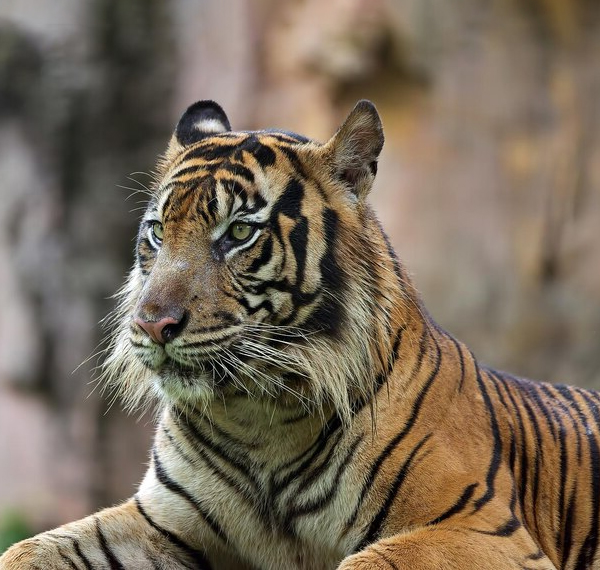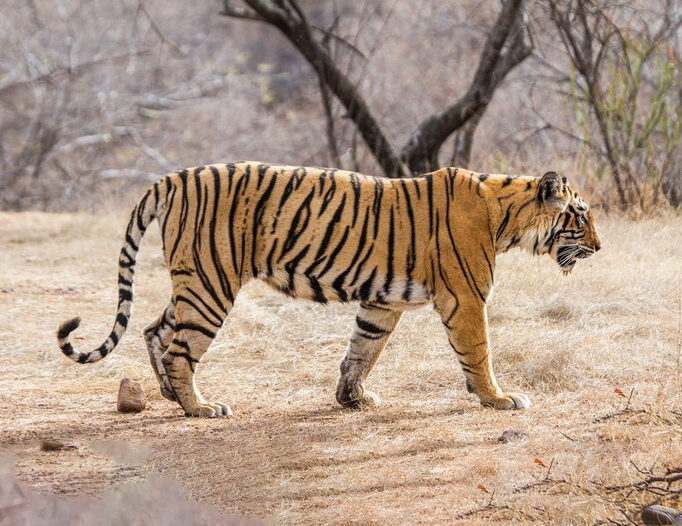Total Weight
Height
Diet
Lifespan
Total Weight
Height
Diet
Lifespan
Royal Bengal Tiger is a majestic animal, which is the largest member of the cat family and is renowned for their power and strength. Sanjay Gandhi Biological Park is famous for captive Royal Bengal Tigers in its normal and white variants. At present, Sanjay Gandhi Biological Park has 4 normal & 3 white-colored Royal Bengal Tigers. The history of the Royal Bengal Tiger at Patna Zoo began in the year 1975 when Delhi Zoo provided one male tiger named Moti. In the year 1980, the Government of Assam gave two female tigresses of wild origin, namely Bulborani and Fauzi. After getting two female partners, Moti started breeding with these two females, and the first tiger cub (female) was born on 01.01.1983 from Bulborani. This marked the beginning of the conservation breeding program for tigers at Patna Zoo.


The tiger enclosure at Patna Zoo offers a spacious and natural habitat, designed to resemble the dense forests and grasslands where tigers thrive in the wild. With ample vegetation, water pools, and shaded resting areas, the enclosure supports the physical and behavioral well-being of these magnificent predators.
Several tigers and tigresses have been brought to Sanjay Gandhi Biological Park from zoos across India, including Hyderabad, Tirupati, and Arunachal Pradesh, under animal exchange programs aimed at improving genetic diversity and strengthening conservation breeding efforts.
Patna Zoo also plays a key conservation role, having the responsibility of providing tigers to the newly established Rajgir Wildlife Safari in Nalanda, ensuring that these iconic big cats continue to inspire and educate future generations.
Visitors can observe these majestic apex predators up close, gaining a deeper understanding of their importance in maintaining ecological balance.
Explore a breathtaking world of tigers and diverse wildlife in an unforgettable park.
Explore natural habitats and discover secrets of majestic creatures like tigers.
| Attribute | Details |
|---|---|
| Weight | Male: 90 - 310 kg, Female: 65 - 170 kg |
| Height | 2.5 - 3.5 feet at the shoulder |
| Diet | Carnivorous — prey includes deer, wild boar, and other large mammals |
| Lifespan | 10 - 15 years in the wild, up to 20 - 26 years in captivity |
| Conservation Status | Endangered (some subspecies Critically Endangered) |
| Population in the Wild | Estimated around 4,500 tigers globally |
| Social Structure | Solitary, territorial animals |
| Unique Behavior | Excellent swimmers, often hunt near water |
| Hunting Pattern | Ambush predators — hunt alone, primarily at night |
| Mane Equivalent | No mane, but distinctive orange coat with black stripes |
| Closest Relatives | Other big cats like lions, leopards, and jaguars (family Felidae) |
Tigers are carnivores, meaning they rely entirely on meat for survival. Their diet varies depending on their habitat and prey availability, but they primarily hunt large herbivores such as deer, wild boar, and antelope. Tigers are skilled ambush predators, using stealth and strength to overpower prey. They usually hunt alone and rely on their powerful jaws and sharp teeth to kill and consume their prey.
Tigers prefer to hunt at night or during dawn and dusk, using their keen night vision to stalk prey. After a successful hunt, they may drag their kill to a secluded spot to eat undisturbed. They can consume up to 40 kg of meat in a single meal, but they don’t eat every day — sometimes going several days between successful hunts.
Open Now
All visits to Patna Zoo help fund our work both at the zoo and worldwide.